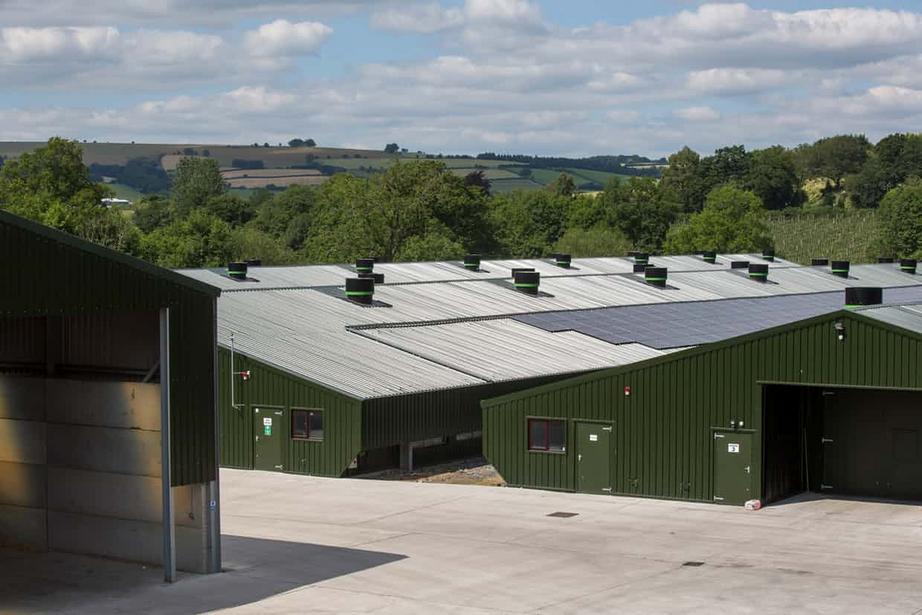UK has nearly 800 livestock mega farms
Exclusive: US-style intensive factory farming of poultry, pigs and cattle is sweeping across the British countryside – raising concerns over animal cruelty

Inside a mega farm in Kington, Herefordshire, England. Photograph: Rob Stothard
Nearly every county in England has at least one industrial-scale livestock farm, with close to 800 US-style mega farms operating across the UK, new research reveals.
The increase in mega farms – which critics describe as “cruel and unnecessary” – is part of a 26% rise in intensive factory farming in six years, a shift that is transforming the British countryside.
Only 12 counties in the UK now host no pig or poultry farms classified as intensive by the Environment Agency. To be classed as intensive, a farm must have warehouses with more than 40,000 birds, 2,000 pigs or 750 breeding sows
Herefordshire has more than 16 million factory-farmed animals, mainly poultry – which means the county has 88 times more factory-farmed animals than it does humans. Shropshire and Norfolk follow closely, with more than 15 million and 12 million animals respectively. Nearly every county in England and Northern Ireland has at least one mega farm, and they are also scattered across Scotland and Wales.
The march of US-style mega farms – defined in the US as facilities housing 125,000 broiler chickens, 82,000 laying hens, 2,500 pigs, 700 dairy or 1,000 beef cattle – has been revealed in an investigation by the Guardian and the Bureau of Investigative Journalism.
Most of these farms have gone unnoticed, despite their size and the controversy surrounding them, in part because many farmers have expanded existing facilities rather than seeking new sites.
Mega farms and industrial-scale farms (that count as intensive, but not “mega” under the US definition) have previously attracted attention because of concerns raised by local residents, over smells, noise and the potential for pollution or disease outbreaks, and by animal welfare campaigners, who argue that factory-style farming in which livestock are rarely or never permitted outdoors prevents animals from expressing their natural behaviour. They also worry that mega farms are pushing smaller farmers out of business, leading to the takeover of the countryside by large agribusinesses, with the loss of traditional family-run units.
Their defenders say that the close controls on industrial-scale farms mean that disease, pollution and the carbon footprint can be kept to a minimum. Such farms also produce for consumers at a lower cost than small-scale farms.
The government does not collate central statistics on mega farms, for which there is no recognised definition under British regulations, but farms classified as intensive need permits. Freedom of information requests and database searches have revealed 789 farms meeting the US mega farm (Concentrated Animal Feeding Operation) definition.
Compassion in World Farming (CIWF), the pressure group, has compiled a map showing hotspots in areas such as Herefordshire and Shropshire, East Anglia and Northern Ireland.
Poultry farms tend to be biggest, with seven out of the 10 largest housing more than 1 million birds, and the biggest two capable of holding 1.7 million and 1.4 million birds. The biggest pig farm found holds about 23,000 pigs, while the biggest cattle farm, in Lincolnshire, houses about 3,000 animals.
Proposals for greenfield mega farms have received a rough ride from the public in recent years. One in Nocton, Lincolnshire, that would have housed more than 8,000 cows, had to be abandoned after local opposition. Another in Foston, Derbyshire, for more than 24,500 pigs was successfully derailed after protests.
For this reason, and for reasons of cost and efficiency, many farmers and large food companies have chosen to expand existing facilities, going under the radar of local opposition.
Emma Slawinski, director of campaigns at CIWF, the pressure group which created the hotspot map, said: “There is a worrying trend towards intensive farming. Bringing animals off the land and cramming them into squalid, inhumane factory farms is not only cruel to animals but also has far-reaching effects on human health, wildlife and the planet. Moving animals away from the countryside into cages and crowded sheds may seem like a space-saving idea, but this ignores the fact that vast amounts of land are used elsewhere to grow feed for them.”
She said animals are kept in “often barren, overcrowded and frequently filthy” conditions despite enough land available to keep them in a natural environment. “North Yorkshire has the highest number of indoor-reared pigs, with over 220,000 of them confined to the inside, unable to forage and explore. This is cruel and unnecessary when we can simply bring the animals outside and rear them on the land.”
However, independent farming experts and industry organisations argue that intensive farming doesn’t hinder animal welfare, and provides cheaper food for consumers. Charles Godfray, director of the Oxford Martin Programme on the Future of Food, said it was not possible to judge the welfare of animals based on the size of farms. “It’s much more about how you do it,” he said. “There are intensive operations which are horrible, and others which are good examples of how to look after animals well and get good outcomes.”
Richard Griffiths, chief executive of the British Poultry Council, said birds reared on intensive farms enjoyed good standards. “These are high health and welfare farms. The husbandry of the birds is the crucial element here – I think people think of hens roaming around a farm, but that image is no longer the case. That’s not how chicken is farmed any more.”

Penrhos Poultry Limited in Kington, England. Photograph: Rob Stothard
He added that pressure from consumers meant it was impractical to keep birds in free range or organic conditions for general consumption. “Last year, we grew almost a billion birds, 95% indoors and 3.4% free range and 1% organic. If we tried to grow a billion birds a year organically, that would be a lot of land. It’s a balancing act, and it’s demand-driven. I don’t think we’ll see a change in systems without consumer demand. At the moment, that demand isn’t there.”
Christine Nicol, professor of veterinary science at the University of Bristol, said the size of a farm was less important than the way animals were looked after, as livestock on small farms could suffer from neglect or poor conditions, particularly in winter. However, she added: “Generally, there is good evidence that very intensive forms of production do seriously constrain internally-motivated behaviours, particularly comfort movements such as stretching, grooming, netsing. That is either because not enough space is provided or insufficient resources are provided. Most animals need quiet resting areas separate from busy areas. These are not always provided, or are insufficient.
“It is not necessarily the case that outdoor access is needed to allow these behaviours. Spacious, protected, semi-indoor areas with natural light can often be better as they allow for the important behaviours while keeping disease risks low. More work needs to be done and much greater incentives offered [to farmers] to encourage improvement, and better public understanding is needed too.”
Zoe Davies, chief executive of the National Pig Association, said bigger farms allowed for better care of animals: “These larger units have more dedicated people – pig units will have specialist vets. There aren’t as many producers that farm pigs outdoors because there’s not a huge demand. The majority are trying to compete with everyone else and their European counterparts. There’s such intense competition.”
For the rest of this article please go to source link below.
Video can be accessed at source link below.

